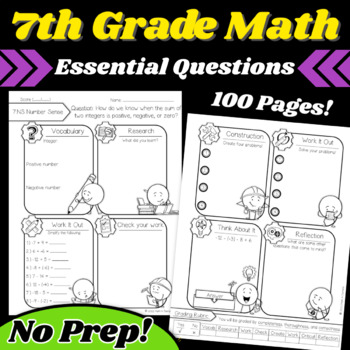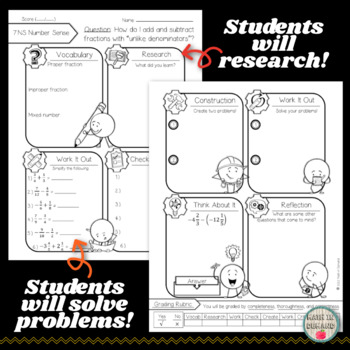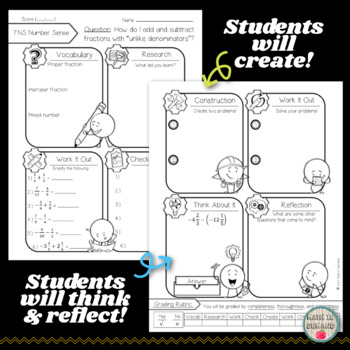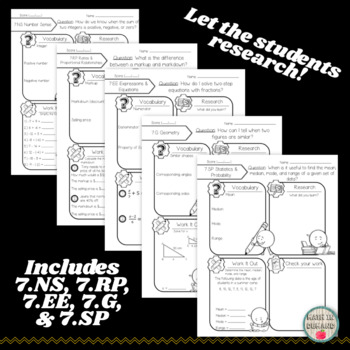This resource includes 48 essential questions for 7th Grade Math. Students will be researching the answer to the essential question. They will solve problems, create their own problem, and reflect. This is set up very student and teacher friendly! There is a grading rubric included at the bottom of each essential question.

The essential questions are given below!
7. NS - Number Sense
1.) How do we know when the sum of two integers is positive, negative, or zero?
2.) What is the difference between taking the opposite of a number and taking the absolute value?
3.) How do we know when the product or quotient of two integers is positive or negative?
4.) When is it useful to find the least common multiple?
5.) When is it useful to find the greatest common factor?
6.) How do I add and subtract fractions with "like denominators"?
7.) How do I add and subtract fractions with "unlike denominators"?
8.) How does multiplying fractions relate to real-world problems?
9.) How does dividing fractions relate to real-world problems?
7. RP - Ratios & Proportional Relationships
1.) What is the difference between a rate and a ratio?
2.) How do I determine the unit rate?
3.) How do I find the constant of proportionality given an equation?
4.) How do I find the constant of proportionality given a graph?
5.) How do I find the constant of proportionality given a table?
6.) What is the relationship between decimals, fractions, and percents?
7.) What is the difference between a markup and a markdown?
8.) How do you calculate sales tax in your state?
9.) How do we calculate a tip?
10.) How do we calculate commission?
11.) How do we calculate the percent of change?
12.) How do we calculate simple interest?
7. EE - Expressions & Equations
1.) How do I know when a term is "common"?
2.) What is the importance of the distributive property?
3.) How do I solve addition or subtraction one-step equations?
4.) How do I solve multiplication one-step equations?
5.) How do I solve one-step equations with fractions?
6.) How do I solve two-step equations (excluding fractions)?
7.) How do I solve two-step equations with fractions?
8.) How do I graph one-step inequalities on a number line?
9.) How do I graph two-step inequalities on a number line?
7. G - Geometry
1.) How do I know if 3 angle measurements form a triangle?
2.) How do I know if 3 side measurements form a triangle?
3.) How can I tell if an angle is adjacent or vertical?
3.) How do I use complementary and supplementary angles to solve for an unknown?
4.) How do I determine the area of a rectangle?
5.) How do I determine the area of a triangle?
6.) How do I determine the area of a circle?
7.) How do I determine the circumference of a circle?
8.) How can I tell when two figures are similar?
9.) How can I use scale drawings to compute actual lengths and areas?
10.) What is the volume of a rectangular prism?
11.) What is the volume of a cone, cylinder, and sphere?
12.) How can I use nets to calculate the surface area of 3-dimensional objects?
7. SP - Statistics & Probability
1.) When is it useful to find the mean, median, mode, and range of a given set of data?
2.) When is it useful to calculate the mean absolute deviation?
3.) How do I organize line plots and histograms given a set of data?
4.) When are box and whisker plots useful?
5.) How do I determine the likelihood of an occurrence of an event?

The answer key is not included since student input will vary on definitions and the creation of problems.

CLICK HERE, to purchase!

Comments
Post a Comment